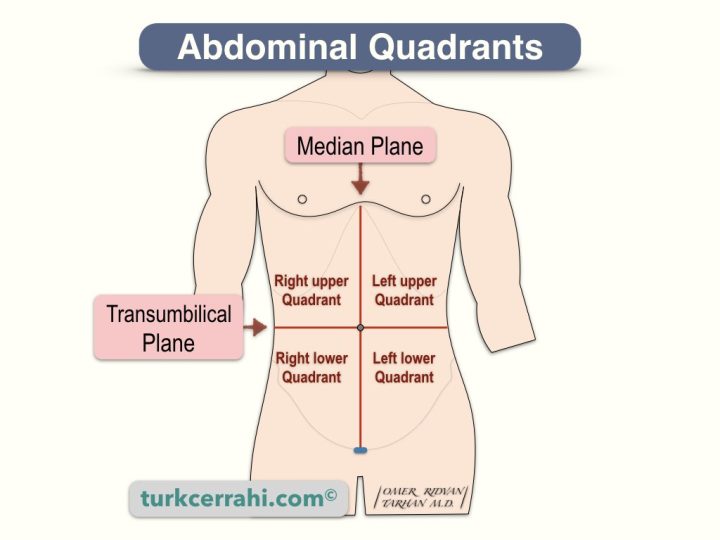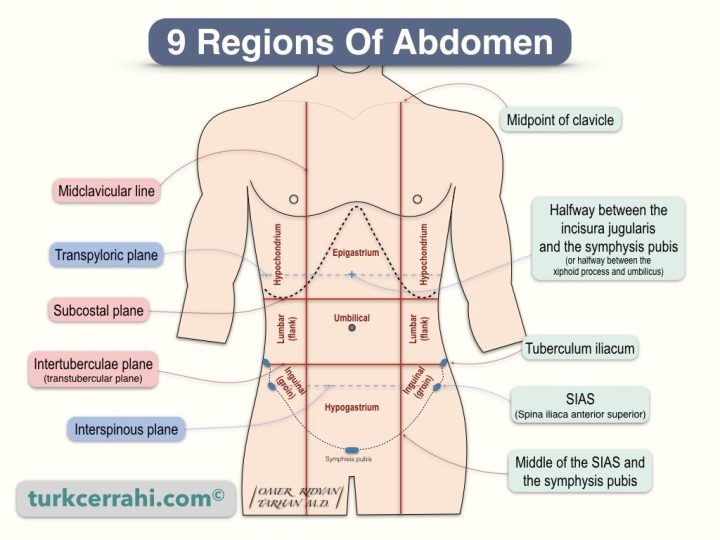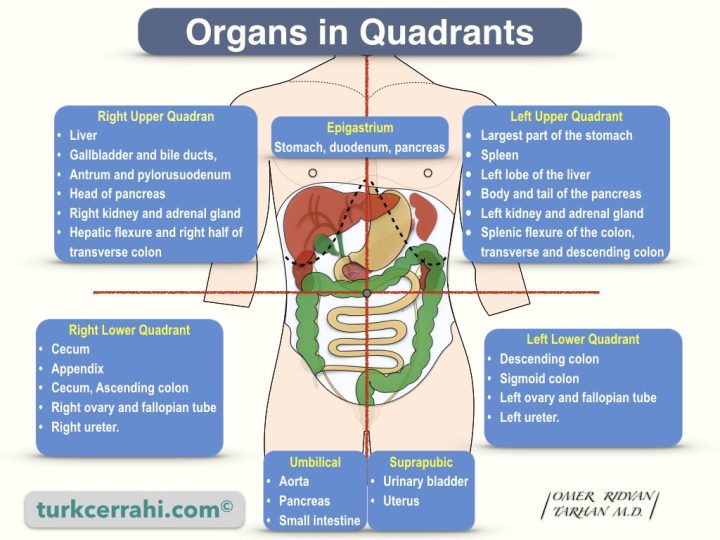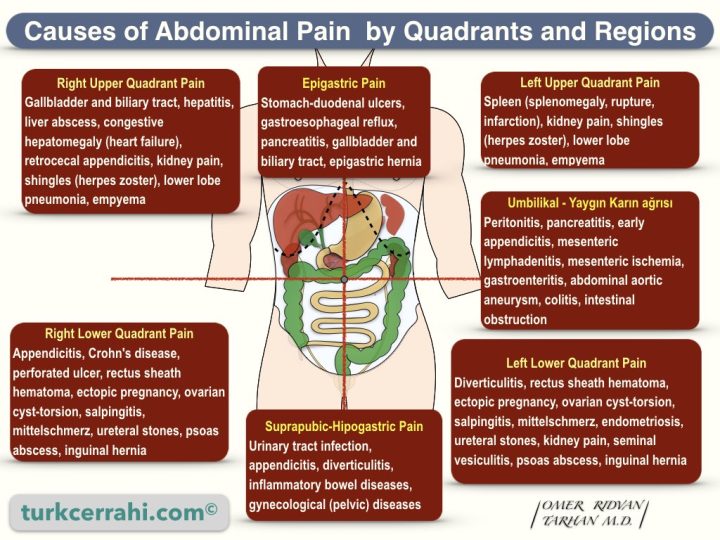Quadrants and Regions of Abdomen

What are the abdominal quadrants and how are they divided?
In the daily practice of medicine, the abdominal regions are divided into 4 quadrants, or 9 regions. This division facilitates agreement among health professionals. More importantly, the quadrant or region where the pain is the worst is usually related to the organs in that quadrant or region. For example, a young man with right lower quadrant pain suggests appendicitis. A middle-aged, thin patient with epigastric abdominal pain suggests a peptic ulcer. Gallstones typically cause right upper quadrant pain (e.g., acute cholecystitis, biliary colic). Diverticulitis comes to mind first in left lower quadrant pain in elderly patients.
Meanings of Some Prefix and Suffixes Used in Abdominal Regions
In the nomenclature of the abdominal regions, "hypo-" refers to the below, "epi-" to the above, "-chond" to the cartilage of the rib, and "-gast-" to the stomach.
Dividing the Abdomen into Four Quadrants
The vertical plane passing through the midline of the body is called the median plane, which divides the body into right and left halves (planum medianum). The horizontal plane passing through the umbilicus is called the transumbilical plane. These two planes divide the abdomen into four quadrants.
- Right upper quadrant
- Right lower quadrant
- Left upper quadrant
- Left lower quadrant
Dividing the Abdomen into Nine Regions

Two horizontal planes and two vertical lines divide the abdomen into nine quadrants.
- Subcostal plane
- Intertubercular plane (in Gray’s drawings) or interspinous plane (in Netter’s drawings)
- Midclavicular lines
The subcostal plane is at the level of the lower border of the 10th rib anteriorly and the L3 vertebral body posteriorly (planum subcostale).
The intertubercular plane is at the level of the iliac tubercle anteriorly and the body of the L5 vertebra posteriorly (transtubercular plane, planum transtuberculare).
The interspinous plane is at the level of the anterior superior iliac spines (ASIS) anteriorly and the lower edge of the L5 vertebra posteriorly (planum interspinale).
Midclavicular lines (vertical lines) traverse the midpoint between the anterior superior iliac spines (ASIS) and the pubic symphysis inferiorly.
The planum transpyloricum runs anteriorly, halfway between the suprasternal notch and the symphysis pubis (or halfway between the xiphoid process and the umbilicus), and posteriorly, along the L1 vertebral body. The transpyloric plane passes through the pylorus, the body of the gallbladder, and the origin of the superior mesenteric artery. This plane is a few centimeters below the costal margin (arch).
9 Region
- Epigastric Region (Regio Epigastrica)
- Left Hypochondrium (Regio Hypochondriaca Sinistra)
- Right Hypochondrium (Regio Hypochondriaca Dextra)
- Umbilical Region (Regio Umbilicalis)
- Right Flank (Regio Lumbalis Dextra)
- Left Flank (Regio Lumbalis Sinistra)
- Hypogastric (Pubic) Region (Regio Hypogastrica)
- Right Groin (Right Inguinal or Iliac Region, Regio Inguinalis Dextra)
- Left Groin (Left Inguinal or Iliac Region, Regio Inguinalis Sinistra)
In daily medical practice, surgeons use more than four quadrants; they also talk about the epigastric, umbilical, and suprapubic regions.
What Organs are Found in the Abdominal Regions?

What Organs Are Located in the Abdominal Quadrants? |
|
|---|---|
Right Upper Quadrant Organs
|
Left Upper Quadrant Organs
|
Right Lower Quadrant Organs
|
Left Lower Quadrant Organs
|
Causes of Abdominal Pain by Quadrants and Regions

Causes of Diffuse (Common) Abdominal Pain
- Peritonitis
- Pancreatitis
- Leukemia
- Sickle cell crisis
- Early appendicitis
- Mesenteric lymphadenitis
- Mesenteric ischemia
- Gastroenteritis
- Abdominal aortic aneurysm
- Ulcerative colitis
- Intestinal obstruction
Causes of Right Upper Quadrant Pain
- Gallbladder and bile ducts
- Biliary colic (gallstone colic, gallbladder attack due to stones)
- Acute cholecystitis
- Cholangitis
- Hemobilia, etc
- Hepatitis
- Liver abscess
- Hepatomegaly due to heart failure
- Peptic ulcer
- Pancreatitis
- Retrocecal appendicitis
- Right kidney pain
- Shingles (herpes zoster)
- Myocardial ischemia
- Lower lobe pneumonia
- Pulmonary empyema
Causes of Right Lower Quadrant Pain
- Appendicitis
- Intestinal obstruction
- Crohn's disease
- Diverticulitis
- Cholecystitis
- Perforated peptic ulcer
- Rectus hematoma
- Ectopic pregnancy
- Ovarian cyst or torsion
- Salpingitis
- Mittelschmerz
- Endometriosis
- Ureteral stone
- Kidney pain
- Seminal vesiculitis
- Psoas abscess
- Inguinal hernia
Causes of Left Upper Quadrant Pain
- Gastritis
- Pancreatitis
- Spleen (splenomegaly, rupture, infarction)
- Kidney pain
- Shingles (herpes zoster)
- Myocardial ischemia
- Lower lobe pneumonia
- Empyema
Causes of Left Lower Quadrant Pain
- Diverticulitis
- Intestinal obstruction
- Rectus hematoma
- Ectopic pregnancy
- Ovarian cyst or torsion
- Salpingitis
- Mittelschmerz
- Endometriosis
- Ureteral stone
- Kidney pain
- Seminal vesiculitis
- Psoas abscess
- Inguinal hernia
Causes of Epigastric Pain
- Stomach-duodenum ulcer
- Gastroesophageal reflux pain
- Pancreatitis
- Gallbladder and biliary tract
- Epigastric hernia
Causes of Suprapubic-Hypogastric Pain
- Urinary tract infection
- Appendicitis
- Diverticulitis
- Inflammatory bowel diseases
- Gynecological (pelvic) diseases